
Search
The Renewable Energy site for Do-It-Yourselfers
Seasonal Benefit of a Reflector for a
South Facing Vertical Solar Collector
|
This study uses the earth-sun simulator
to estimate the improvement in energy output that can be achieved
using a reflector to provide extra energy input to a vertical south facing solar
collector.
For this evaluation, the vertical collector is square, and the
reflector is a square of the same size as the collector. The reflector
extends out from the bottom of the collector and is tilted slightly up
or down depending on the season. The evaluation is
done for the winter and summer solstice and for the equinox.
This test is for latitude 45 degrees -- results will vary some for
other latitudes.
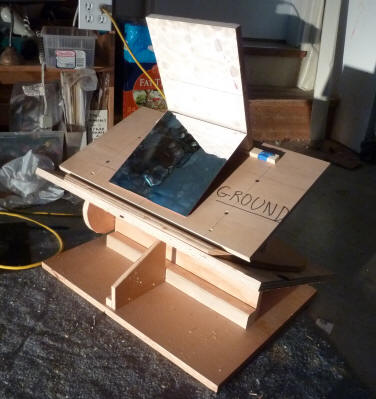
This study is an example of using the earth/sun simulator is used for
the evaluation...
|
|
Table of Contents
- Bottom Line Results...
- Test Setup...
- Winter Solstice Test...
- Equinox Test..
- Summer Solstice Test...
Bottom Line
For this situation of a square, south facing, vertical collector at 45
degrees latitude with a same size square reflector extending southward from the
bottom of the collector, the general results are:
- The reflector angle that provides full illumination of
the collector is south end down 15 degrees for the winter solstice, up 15
degrees for the summer solstice, and about level for the equinoxes.
- The noon time gain for such a reflector is about 1.8
for the winter solstice, 2.2 for the equinoxes, and 3.0 for the summer solstice.
- For the square reflector the gain falls off on either
side of noon because the reflected pattern slides off to the east or west of the
collector. By 2pm, the reflected pattern is down to covering 50 to 70% of
the collector.
For more details, see below. If this does not fit your situation, then
build an earth-sun simulator of your own... its
fun :)
Test Setup
The earth/sun simulator is used to
estimate and understand the effect and benefits of a reflector mounted at the
bottom of a south facing vertical solar collector for each season of the year,
and for different times of day.
In this setup, the collector is a square and is mounted vertically. The
reflector is a square of the same size and mounted at the bottom of the
collector and extending south from the base of the collector.
In general, for each season, the reflector is angle is set such that at 12
noon, the reflected pattern of light from the reflector covers the full surface
of the collector. This offers the advantage of spreading the light over
the full surface of the collector, and the incidence angle of the reflected
light on the collector is in the neighborhood of 45 degrees, which is not so
large as to have a the collector glazing reflecting off a lot of the light from
the reflector. The result is that the reflector is angled slightly down
for the winter, slightly up for the summer, and near horizontal at the equinox.
The sections below show the reflected patterns and benefits for each season
of the year.
Winter Solstice
Winter solstice at 12 noon.
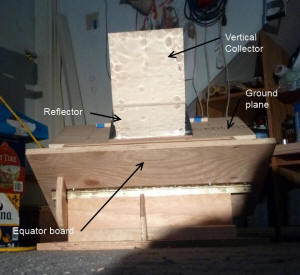
View from position of the sun at solar noon
on the winter solstice. |
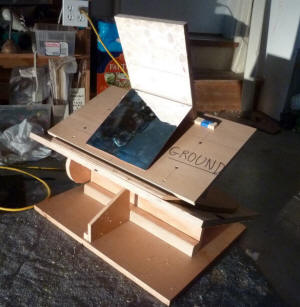
Same from the side. |
The left picture is taken roughly from the position of the sun looking toward
the collector and reflector.
The simulator is set to the to the winter solstice (equator board tipped down in
back), and the turntable is set to 12 noon.
The reflector is angled down a bit in front such that the reflected pattern of
light pattern just fills the collector but no more.
The tilt down of the mirror is about 15 degrees below horizontal (tilted down
toward the south).
Winter solstice at 2 pm
The two pictures just above are at the winter solstice at 2 pm.
Note the pattern of the reflected light on the collector in the right picture --
it is now only covering about half of the collector area. So, if the
reflector is the same width as the collector, the benefit of the reflector falls
off in both the morning and afternoon because the reflected light patter is
skewed east or west. This is why it is an advantage to make the reflector
wider than the collector if you can easily do this.
The light levels on the surface of the collector, ground, and reflector were
measured with a light meter. The absolute readings don't really mean
anything, but the ratios of the readings give an idea how much the reflector is
increasing the energy input.
| Ground |
135 |
| On reflector surface |
218 |
| On collector - no reflector |
230 |
| On collector - with
reflector |
410 |
So, at noon, the energy gain for the collector is (410/230) = 1.78
This gain will not be as large earlier in the morning or later in the
afternoon because (as shown above) the reflected light pattern does not cover
the whole collector.
Spring and Fall Equinox
Spring or fall equinox at 12 noon
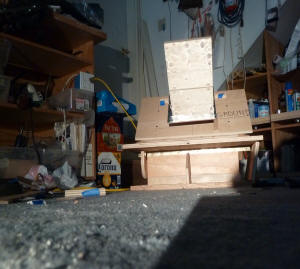
View from position of the sun at the equinox. |
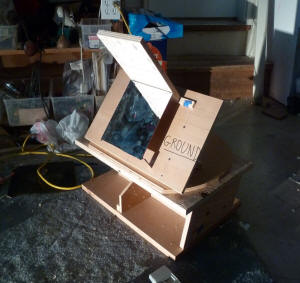
side view at equinox. |
The left picture is taken roughly from the position of the sun looking toward
the collector and reflector.
The simulator is set to the to the equinox (equator board is horizontal), and
the turntable is set to 12 noon.
The reflector is nearly level and with this angle, the reflected pattern of light
pattern just fills the collector but no more.
Equinox at 2 pm
The two pictures just above are at the equinox at 2 pm.
Note the pattern of the reflected light on the collector -- it is now only
covering perhaps 70% of the collector area.
The light levels on the surface of the collector, ground, and reflector were
measured with a light meter. The absolute readings don't really mean
anything, but the ratios of the readings give an idea how much the reflector is
increasing the energy input.
| Ground |
270 |
| On reflector surface |
288 |
| On collector - no reflector |
210 |
| On collector - with
reflector |
458 |
So, at noon, the energy gain for the collector is (458/210) = 2.18
This gain will not be as large earlier in the morning or later in the
afternoon because (as shown above) the reflected light pattern does not cover
the whole collector.
Summer Solstice
Summer solstice at 12 noon.
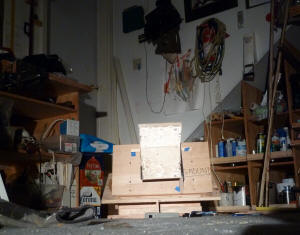
Reflector and collector at summer solstice as
seen from position of sun. |
.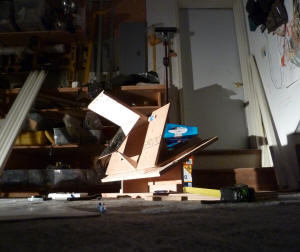
Side view -- summer solstice. |
The left picture is taken roughly from the position of the sun looking toward
the collector and reflector.
The simulator is set to the to the summer solstice (equator board tipped down in
in front), and the turntable is set to 12 noon.
The reflector is angled up a bit in front such that the reflected pattern of
light pattern just fills the collector but no more.
The tilt up of the mirror is about 14 degrees above horizontal (the south end is higher than the north end).
Summer solstice at 2 pm
The two pictures just above are at the summer solstice at 2 pm.
Note the pattern of the reflected light on the collector in the right picture --
it is now only covering about 70% of the collector area. So, if the
reflector is the same width as the collector, the benefit of the reflector falls
off in both the morning and afternoon because the reflected light patter is
skewed east or west. This is why it is an advantage to make the reflector
wider than the collector if you can easily do this.
The light levels on the surface of the collector, ground, and reflector were
measured with a light meter. The absolute readings don't really mean
anything, but the ratios of the readings give an idea how much the reflector is
increasing the energy input.
| Ground |
362 |
| On reflector surface |
365 |
| On collector - no reflector |
125 |
| On collector - with
reflector |
404 |
So, at noon, the energy gain for the collector is (404/125) = 2.98
Kind of an amazing improvement, but it makes sense in that the solar
incidence angle on the collector is so large that it is not receiving much
useful radiation, whereas the reflector is pointed nearly right at the sun.
Interesting that the radiation level on the collector including the direct and
the reflected radiation is almost the same as it is for the winter solstice and
the summer solstice.
This gain will not be as large earlier in the morning or later in the
afternoon because (as shown above) the reflected light pattern does not cover
the whole collector.
Gary June 4, 2011


